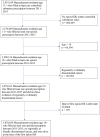Potentially Inappropriate Opioid Prescribing, Overdose, and Mortality in Massachusetts, 2011-2015
- PMID: 29948815
- PMCID: PMC6109008
- DOI: 10.1007/s11606-018-4532-5
Potentially Inappropriate Opioid Prescribing, Overdose, and Mortality in Massachusetts, 2011-2015
Abstract
Background: Potentially inappropriate prescribing (PIP) may contribute to opioid overdose.
Objective: To examine the association between PIP and adverse events.
Design: Cohort study.
Participants: Three million seventy-eight thousand thirty-four individuals age ≥ 18, without disseminated cancer, who received prescription opioids between 2011 and 2015.
Main measures: We defined PIP as (a) morphine equivalent dose ≥ 100 mg/day in ≥ 3 months; (b) overlapping opioid and benzodiazepine prescriptions in ≥ 3 months; (c) ≥ 4 opioid prescribers in any quarter; (d) ≥ 4 opioid-dispensing pharmacies in any quarter; (e) cash purchase of prescription opioids on ≥ 3 occasions; and (f) receipt of opioids in 3 consecutive months without a documented pain diagnosis. We used Cox proportional hazards models to identify PIP practices associated with non-fatal opioid overdose, fatal opioid overdose, and all-cause mortality, controlling for covariates.
Key results: All six types of PIP were associated with higher adjusted hazard for all-cause mortality, four of six with non-fatal overdose, and five of six with fatal overdose. Lacking a documented pain diagnosis was associated with non-fatal overdose (adjusted hazard ratio [AHR] 2.21, 95% confidence interval [CI] 2.02-2.41), as was high-dose opioids (AHR 1.68, 95% CI 1.59-1.76). Co-prescription of benzodiazepines was associated with fatal overdose (AHR 4.23, 95% CI 3.85-4.65). High-dose opioids were associated with all-cause mortality (AHR 2.18, 95% CI 2.14-2.23), as was lacking a documented pain diagnosis (AHR 2.05, 95% CI 2.01-2.09). Compared to those who received opioids without PIP, the hazard for fatal opioid overdose with one, two, three, and ≥ four PIP subtypes were 4.24, 7.05, 10.28, and 12.99 (test of linear trend, p < 0.001).
Conclusions: PIP was associated with higher hazard for all-cause mortality, fatal overdose, and non-fatal overdose. Our study implies the possibility of creating a risk score incorporating multiple PIP subtypes, which could be displayed to prescribers in real time.
Keywords: mortality; opioids; overdose; potentially inappropriate prescribing.
Conflict of interest statement
The authors declare that they do not have a conflict of interest.
Figures
Similar articles
-
Effect of Age on Opioid Prescribing, Overdose, and Mortality in Massachusetts, 2011 to 2015.J Am Geriatr Soc. 2019 Jan;67(1):128-132. doi: 10.1111/jgs.15659. Epub 2018 Nov 24. J Am Geriatr Soc. 2019. PMID: 30471102 Free PMC article.
-
Opioid overdose deaths and potentially inappropriate opioid prescribing practices (PIP): A spatial epidemiological study.Int J Drug Policy. 2019 Jun;68:37-45. doi: 10.1016/j.drugpo.2019.03.024. Epub 2019 Apr 11. Int J Drug Policy. 2019. PMID: 30981166 Free PMC article.
-
Controlled Substance Prescribing Patterns--Prescription Behavior Surveillance System, Eight States, 2013.MMWR Surveill Summ. 2015 Oct 16;64(9):1-14. doi: 10.15585/mmwr.ss6409a1. MMWR Surveill Summ. 2015. PMID: 26469747
-
Inappropriate opioid prescribing practices: A narrative review.Am J Health Syst Pharm. 2019 Aug 1;76(16):1231-1237. doi: 10.1093/ajhp/zxz092. Am J Health Syst Pharm. 2019. PMID: 31251321 Review.
-
Predictors of fatal and nonfatal overdose after prescription of opioids for chronic pain: a systematic review and meta-analysis of observational studies.CMAJ. 2023 Oct 23;195(41):E1399-E1411. doi: 10.1503/cmaj.230459. CMAJ. 2023. PMID: 37871953 Free PMC article.
Cited by
-
A machine learning-based risk warning platform for potentially inappropriate prescriptions for elderly patients with cardiovascular disease.Front Pharmacol. 2022 Aug 11;13:804566. doi: 10.3389/fphar.2022.804566. eCollection 2022. Front Pharmacol. 2022. PMID: 36034817 Free PMC article.
-
Use of Opioid Overdose Deaths Reported in One State's Criminal Justice, Hospital, and Prescription Databases to Identify Risk of Opioid Fatalities.JAMA Intern Med. 2019 Jul 1;179(7):980-982. doi: 10.1001/jamainternmed.2018.8757. JAMA Intern Med. 2019. PMID: 30985862 Free PMC article.
-
Opioid initiation and injection transition in rural northern New England: A mixed-methods approach.Drug Alcohol Depend. 2020 Dec 1;217:108256. doi: 10.1016/j.drugalcdep.2020.108256. Epub 2020 Aug 30. Drug Alcohol Depend. 2020. PMID: 32947174 Free PMC article.
-
Opioid Prescribing and Use Patterns in Postsurgical Facial Trauma Patients.Plast Reconstr Surg. 2020 Mar;145(3):780-789. doi: 10.1097/PRS.0000000000006588. Plast Reconstr Surg. 2020. PMID: 32097326 Free PMC article.
-
Rapid Discontinuation of Chronic, High-Dose Opioid Treatment for Pain: Prevalence and Associated Factors.J Gen Intern Med. 2022 May;37(7):1603-1609. doi: 10.1007/s11606-021-07119-3. Epub 2021 Oct 4. J Gen Intern Med. 2022. PMID: 34608565 Free PMC article.
References
-
- Liu Y, Logan JE, Paulozzi LJ, Zhang K, Jones CM. Potential misuse and inappropriate prescription practices involving opioid analgesics. Am J Manag Care. 2013;19:648–665. - PubMed
Publication types
MeSH terms
Substances
LinkOut - more resources
Full Text Sources
Other Literature Sources
Molecular Biology Databases


